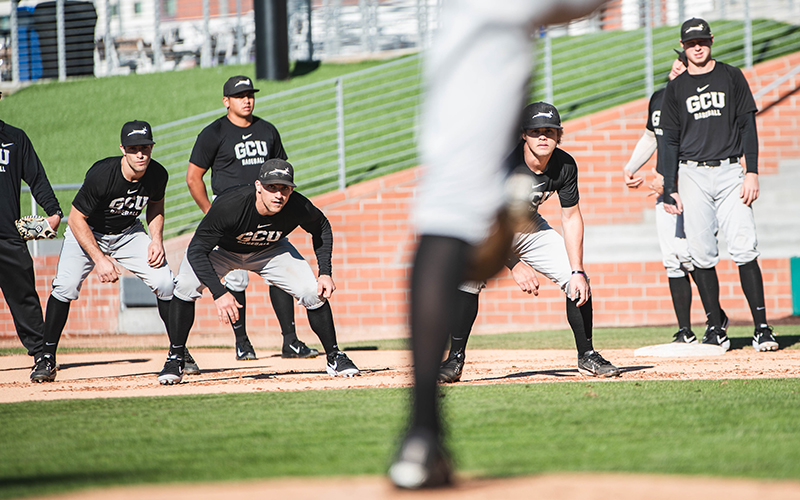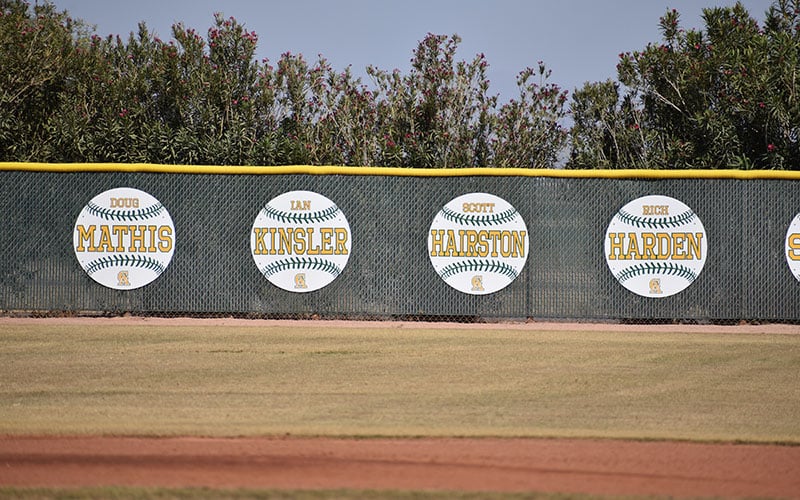
Grand Canyon University’s baseball program returned to NCAA Division I competition in 2014. Finding top junior college players from the state helped the rebuild. (Photo by Tyler Rittenhouse/Cronkite News)

More than 400 players from Arizona’s 14 junior college programs are listed in baseball-reference.com’s professional player database. Several of them have landed at Grand Canyon University. (Photo by Tyler Rittenhouse/Cronkite News)
PHOENIX – Some of the names that dot the outfield wall are familiar to Arizona State baseball followers.
Hubie Brooks. Marty Barrett. Ken Phelps. Mike Devereaux.
All went on to play in the major leagues after passing through ASU. But the placards aren’t on the ASU campus. They’re all hung on the fence that surrounds Mesa Community College’s baseball field.
ASU, Arizona and Grand Canyon University are storied baseball programs in the state that have produced scores of professional players. But even some of the best of those players performed first in Arizona’s fertile community college system, using junior college ball as a bridge to four-year programs and on to the pros.
There are similar success stories at most of Arizona’s traditional junior college powerhouses like Central Arizona College in Coolidge, Yavapai College in Prescott and Pima Community College in Tucson.
More than 400 players from the state’s 14 junior college programs are listed in baseball-reference.com’s professional player database. Central Arizona, Mesa CC and Yavapai have combined to win nine Division I NJCAA championships since 1970, and Mesa added a Division II title in 2014.
“There are some traditionally strong programs in Arizona,” said Ben Greenspan, recruiting coordinator for Arizona State’s baseball program. “We’re fortunate to be in a place with so many great junior college programs.”
Players are often fortunate to have two-year programs as an option, too.
R.J. Dabovich, a 6-foot-3 right-handed pitcher from Pueblo, Colorado, was taken by Kansas City in the 18th round of the MLB Draft after playing at Central Arizona. But when he was unable to come to terms on a contract with the Royals, he decided to play for the Sun Devils.
And Greenspan needed him.
Despite a history that includes 22 College World Series appearances and five national titles, the Sun Devils are coming off back-to-back 23-32 seasons and haven’t reached Omaha since 2010.
With only 11 pitchers on the roster, ASU and Greenspan were in search of pitchers who could contribute immediately. He looked to junior college programs to find them.
“As we look at our roster for the next year, we try and evaluate, ‘What holes do we have that need to be immediately addressed?’ ” Greenspan said. “The junior college (route) is the best place to go for immediate, game-ready guys that can step in right away and play.”
It turned out to be a good fit for Dabovich.
“After I got drafted, me and my advisor talked, and we said that to get leverage in the draft, the best choice would be to find a four-year college to sign with,” Dabovich said.
“I visited a couple schools, but, when I came here, I fell in love with the coaches, the program and the community around it.
“It’s such a storied program that has had a couple down years, and I felt that with the returners, we could really build and be back to where we were.”
Grand Canyon University’s budding program returned to NCAA Division I competition in 2014 after a 16-year hiatus. The Antelopes, who competed at the Division I level as members of the Western Athletic Conference from 1995 through 1998, began a four-year transition period back to the WAC 2014 and became postseason eligible last season.
Gregg Wallis, Grand Canyon’s recruiting coordinator and assistant coach, said that attracting local junior college players was an important component of Grand Canyon’s plan as the school made the transition.
“We’ve always found the kids we recruit from Arizona come in and you get a pretty good idea from what they’ve done at their junior college how they’re going to perform here,” Wallis said.
Pikai Winchester and Nick Ohanian are two Arizona junior college transfers that Wallis lured to GCU.
Ohanian, a Phoenix native, suffered an injury his junior year of high school at Hamilton High in Chandler and did not see many college offers. He still loved the game, but because of the cost of a four-year school, he decided to take the junior-college path.
After two seasons at Mesa CC, he transferred to GCU where he would be close to home and playing for a coaching staff that he trusted.
“The biggest thing in me coming here was coach Andy Stankiewicz,” Ohanian said. “You hear nothing but great things about him. He’s a great person and coach. As a person I’ve been able to grow since being here, and I attribute that to Stank.”
Winchester found his way to Central Arizona in 2016 after playing his high school baseball in Honolulu, Hawaii. He thought he was going to play in his home state.
“I was committed to Hawaii first, and then everything fell through there,” he said. “I got drafted out of high school in the 40th round, and I thought I might as well try again at a junior college.”
Winchester batted above .360 in each of his two seasons at Central Arizona and won an American Baseball Coaches Association/Rawlings Gold Glove at third base. He transferred to GCU and won all-Western Athletic Conference honors as a designated hitter there last season.
Having earned their way at the junior-college level, Dabovich, Ohanian and Winchester have a greater appreciation of Division I programs.
“You’re kind of on your own at a junior college, compared to here where it’s really professional and there’s a lot of coaching,” said Ohanian. “It’s you against the world (in junior college). You have to do your thing and then move on.”
On opening night for the Antelopes last season, Winchester saw how different the atmosphere can be at a four-year school compared junior college. GCU played host to nationally ranked Texas Christian in that game as the Antelopes unveiled newly renovated Brazell Field at GCU Ballpark. The game drew 3,749 fans and Winchester had two hits in his debut.
He said he had never played in front of a crowd like it before.
“The only adjustment, really, was playing in front of thousands of fans every night,” he said. “I just look at it as another game, though, even if there are people yelling.”
Winchester and Ohanian have had the good fortune to be part of Grand Canyon’s return to Division 1 competition and experience the improved baseball park. Brazell Field at GCU Ballpark was one piece of the school’s $1-billion “10 in 2” initiative to construct or renovate 10 athletic facilities within two years in preparation for the jump to Division I.
The original baseball playing surface and outfield wall were preserved. A new stadium was constructed around the field, which is named after Dr. Dave Brazell, who founded the program, coached the team and maintained the field. Now there are covered grandstands, chair-back seating, new sound and lighting systems, a larger pressbox and modern technology.
“When I committed, there were still bleachers,” Ohanian said, laughing. “It looked a lot like my high school. I got here, and they talked about the new stadium. But, to see it getting built; it was amazing. To see the old bleachers get torn down, it was pretty incredible.”
Wallis and Greenspan said recruiting junior college players can be an easier process than attracting high school prospects.
“The exciting thing about junior college prospects is, you recruit them, they commit, and they’re here for the next year,” said Greenspan. “The maturity is big, too. I think the high school guys when you are recruiting them, there is a little bit more of the song and dance.
“The junior college guys are older. They know what they’re looking for.”
Maturity is something that has translated into a leadership role for Winchester, who is in his senior season at GCU.
“We have to lead by example, take these younger guys under our wings and show them what it’s like to be a D-1 baseball player.” Winchester said.
Wallis said Winchester was “thrown right into the middle of our lineup” and emerged as a player the coaching staff depends upon for leadership.
“He’s a quiet leader, but he leads by example,” Wallis said. “He’s well-liked in the clubhouse and a leader on the field.”
Winchester and Ohanian are winding down their college careers while Dabovich is just getting started at Arizona State. All three might have gone to other programs around the country after playing in Arizona junior colleges, but they all decided to remain in the state.
“I love Arizona,” Dabovich said. “It’s a good place. A baseball Mecca.”
Connect with us on Facebook.
